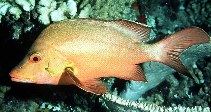個人による観察記録の追加 Fish Watcher
| Native range | All suitable habitat | Point map | Year 2050 |

|
| This map was computer-generated and has not yet been reviewed. |
| Lutjanus gibbus AquaMaps Data sources: GBIF OBIS |
Upload your 写真 and ビデオ
Pictures | Videos | Stamps, coins, misc. | グーグルの画像Lutjanus gibbus
Picture by Randall, J.E.
Pictures | Videos | Stamps, coins, misc. | グーグルの画像Lutjanus gibbus
Picture by Randall, J.E.
Saudi Arabia country information
Common names:
Asmoodi, عصموديّ أحمر أَحْدَب
Occurrence: native
Salinity: marine
Abundance: | Ref:
Importance: | Ref:
Aquaculture: | Ref:
Regulations: | Ref:
Uses: no uses
Comments: Also Ref. 100374, 114551.
National Checklist:
Country Information: https://www.cia.gov/library/publications/resources/the-world-factbook/geos/sa.html
National Fisheries Authority:
Occurrences: Occurrences Point map
Main Ref: Allen, G.R., 1985
National Database:
Occurrence: native
Salinity: marine
Abundance: | Ref:
Importance: | Ref:
Aquaculture: | Ref:
Regulations: | Ref:
Uses: no uses
Comments: Also Ref. 100374, 114551.
National Checklist:
Country Information: https://www.cia.gov/library/publications/resources/the-world-factbook/geos/sa.html
National Fisheries Authority:
Occurrences: Occurrences Point map
Main Ref: Allen, G.R., 1985
National Database:
Common names from other countries
分類 / Names 共通名の | 類義語 | Catalog of Fishes(部類, 種) | ITIS | CoL | WoRMS | Cloffa
> Eupercaria/misc (Various families in series Eupercaria) > Lutjanidae (Snappers) > Lutjaninae
Etymology: Lutjanus: Malay, ikan lutjan, name of a fish.
More on author: Forsskål.
Etymology: Lutjanus: Malay, ikan lutjan, name of a fish.
More on author: Forsskål.
Environment: milieu / climate zone / depth range / distribution range 生態学
分布 国々 | 国連食糧農業機関の区域 | エコシステム | 事件 | Point map | 導入 | Faunafri
Indo-Pacific: Red Sea and East Africa to the Line and Society islands, north to southern Japan, south to Australia.
Length at first maturity / サイズ / 重さ / 年齢
Maturity: Lm 21.5 range ? - ? cm
Max length : 56.8 cm FL オス/雌雄の選別がない; (Ref. 125599); common length : 45.0 cm TL オス/雌雄の選別がない; (Ref. 5450); 最大公表体重: 2.8 kg (Ref. 125599); 最大記録サイズ: 18 年 (Ref. 2293)
Max length : 56.8 cm FL オス/雌雄の選別がない; (Ref. 125599); common length : 45.0 cm TL オス/雌雄の選別がない; (Ref. 5450); 最大公表体重: 2.8 kg (Ref. 125599); 最大記録サイズ: 18 年 (Ref. 2293)
簡単な記述 検索表 | 形態学 | 形態計測学
背面の脊椎 (合計) : 10; 背鰭 (合計) : 13 - 14; 肛門の骨: 3; 臀鰭: 8. This species is distinguished by the following characters: body moderately deep; greatest depth 2.2-2.5 in SL; preopercular notch and knob well developed; vomerine tooth patch crescentic, without a medial posterior extension; gill rakers of first gill arch 9-10 + 115-20 = 25-30 (including rudiments); caudal fin distinctly forked with rounded lobes. Colour red to greyish, an orange hue on lower part of opercle and in pectoral fin axil; fins red (pectoral fins) or usually dark brown to blackish; soft part of dorsal fin, anal and caudal fins with a narrow white margin; juveniles with a large round black spot at base of caudal fin (Ref. 9821, 90102).
Adults mainly inhabit coral reefs, sometimes forming large aggregations, which are mostly stationary during the day. Juveniles occur in seagrass beds, also in mixed sand and coral habitats of shallow sheltered reefs (Ref. 1602). Sub-adults commonly form very large schools that are stationary or drift slowly along slopes during the day. Large individuals along coastal slopes at moderate depths (Ref. 48635). Benthopelagic (Ref. 58302). Feed on fishes, and a variety of invertebrates including shrimps, crabs, lobsters, stomatopods, cephalopods, echinoderms and ophiuroids (Ref. 55). Caught mainly with handlines, traps, and gill nets. Commonly sold fresh. Sometimes causes ciguatera poisoning, particularly around the Pacific islands (Ref. 9821).
Life cycle and mating behavior 成熟 | 繁殖 | 放精 | 卵 | 生産力 | 幼生
Off East Africa spawning occurs mainly during spring and summer.
主な参考文献
Upload your references | 参考文献 | コーディネーター | 協力者
Allen, G.R., 1985. FAO Species Catalogue. Vol. 6. Snappers of the world. An annotated and illustrated catalogue of lutjanid species known to date. FAO Fish. Synop. 125(6):208 p. Rome: FAO. (Ref. 55)
Human uses
水産業: 商業; ゲームフィッシュ: はい; 水族館・水槽: 公共の水族館
FAO(水産業: 代謝; publication : search) | FishSource | 私達の周りの海
より多くの情報
Population dynamics
成長のパラメーター
Max. ages / sizes
Length-weight rel.
Length-length rel.
体長組成
Mass conversion
補充
豊度
成長のパラメーター
Max. ages / sizes
Length-weight rel.
Length-length rel.
体長組成
Mass conversion
補充
豊度
Physiology
Body composition
Nutrients
酸素消費
水泳形態
泳ぐ速さ
Visual pigments
Fish sound
Diseases & Parasites
Toxicity (LC50s)
Body composition
Nutrients
酸素消費
水泳形態
泳ぐ速さ
Visual pigments
Fish sound
Diseases & Parasites
Toxicity (LC50s)
Genetics
遺伝子の
Heterozygosity
遺伝
遺伝子の
Heterozygosity
遺伝
用具
Bio-Quiz | E-book | 野外観察図鑑 | 検索表 | Length-frequency wizard | 生活史の基盤ツール | 目的のマップ | Classification Tree
| Catch-MSY |
特記事項
XMLをダウンロードして下さい
インターネットの情報源
Alien/Invasive Species database | Aquatic Commons | BHL | Cloffa | Websites from users | Check FishWatcher | CISTI | Catalog of Fishes(部類, 種) | DiscoverLife | DORIS | ECOTOX | Faunafri | Fishtrace | GenBank(ゲノム, ヌクレオチド) | GloBI | GOBASE | | Google Books | Google Scholar | Google | IGFA World Record | MitoFish | 国のデーターベース | Otolith Atlas of Taiwan Fishes | PubMed | Reef Life Survey | Scirus | SeaLifeBase | 生命の木 | Wikipedia(行く, 検索する) | World Records Freshwater Fishing | 動物に関する記録
Estimates based on models
Preferred temperature (Ref. 115969): 24.5 - 29.1, mean 28 (based on 2228 cells).
Phylogenetic diversity index (Ref. 82804): PD50 = 0.5000 [Uniqueness, from 0.5 = low to 2.0 = high].
Bayesian length-weight: a=0.01549 (0.01390 - 0.01726), b=2.97 (2.95 - 2.99), in cm Total Length, based on LWR estimates for this species (Ref. 93245).
栄養段階 (Ref. 69278): 4.1 ±0.3 se; based on diet studies.
回復力 (Ref. 120179): 手段, 1.4年~4.4年の倍増期間の最小個体群 (K=0.31-0.40; tmax=18).
Prior r = 0.57, 95% CL = 0.37 - 0.85, Based on 1 data-limited stock assessment.
Fishing Vulnerability (Ref. 59153): Low to moderate vulnerability (33 of 100).
Climate Vulnerability (Ref. 125649): High vulnerability (63 of 100).




